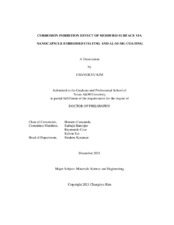| dc.description.abstract | Corrosion of metals has been nominated as one of the major issues that contribute to material degradation which can ultimately trigger economic losses via unexpected accidents including material failure. The service period of metal can be extended by applying an either organic or inorganic coating. Nevertheless, the conventional coating types have shown their limitations regarding substrate protection, especially from the unintentionally formed defects or during their longer service time. Therefore, the improved coating systems have been required to extend the service period of the substrate by providing better protection.
To achieve enhanced and longer protection versus the conventional organic coating system, the application of corrosion inhibitor-loaded nanocapsules into the coating matrix was proposed as such technique allows overcoming the limitations existed in the case of the coating with directly applied corrosion inhibitor. According to the proposed studies, a corrosion inhibitor of triethanolamine was encapsulated with the double-shell-structured nanocapsules then embedded into the organic coating system that contained artificial defects. Upon the exposure to the corrosive electrolyte, the exposed metal surface experienced corrosion regime that caused pH gradient by couple anodic and cathodic reactions, and such pH gradient promoted autonomous healing of the corroded area by an accelerated release of the corrosion inhibitor from the nearby nanocapsules. As a result, by forming an inhibiting layer owing to the successfully released corrosion inhibitor, the coating embedded with the nanocapsules revealed considerably delayed corrosion activity, allows a longer service period of such system at last.
To improve the anti-corrosion performance of the conventional Al-Si inorganic coating for hot-press-formed ultra-high-strength-steel system, the addition of Mg element was proposed. According to the proposed studies, the structural changes triggered by the addition of Mg element has been addressed, in both hot-dip-aluminizing and hot-press-forming processes. Such structural changes, including more compact surface layer with segregated Mg, thicker crack-free soft layer, and pore-filling effect of corrosion products, caused an improved anti-corrosion performance in terms of higher polarization resistance compared to the conventional Al-Si coating system. | |






